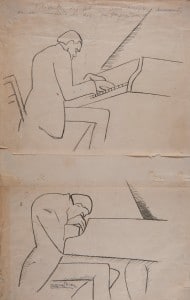Artist
Daniel Vázquez Díaz
(Nerva, Huelva, 1882-Madrid, 1969)
Born in Nerva, Huelva in 1882, Vazquez Diaz moves to Madrid in 1903 to dedicate himself entirely to painting, where he begins to make copies of works of the Prado Museum and meets artists as Solana, Darío de Regoyos or Juan Gris. In 1906 he settles in Paris where he is an apprentice of the sculptor Antoine Bourdelle and becomes acquainted with Picasso, Braque, and Modigliani. The influence of these and of his friend Juan Gris will open his art to cubism, where his production thereafter depicts solid and rigorous planes. In 1918 he returns to Spain and settles in Madrid where he will alternate his artistic activity with teaching classes in his studio and at the School of Fine Arts of San Fernando. His works are predominately portraits where he seeks to convey the soul of public figures divested of all anecdotal elements. Among his works are the portraits of outstanding figures such as Manuel de Falla, Ignacio Zuloaga or authors Juan Ramón Jimenez or Miguel de Unamuno. In his landscape and still lifes themes he largely combines realism with cubism. Nevertheless, some of his most outstanding works are the mural paintings done between 1927 and 1930 for the Monastery of La Rabida in Huelva with history of the Discovery of America. Ever since then, he is honoured with awards and recognitions.


